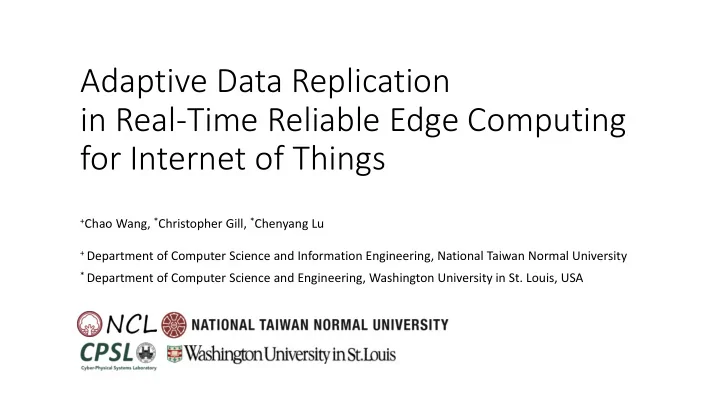

Adaptive Data Replication in Real-Time Reliable Edge Computing for Internet of Things + Chao Wang, * Christopher Gill, * Chenyang Lu + Department of Computer Science and Information Engineering, National Taiwan Normal University * Department of Computer Science and Engineering, Washington University in St. Louis, USA
Challenges in performant IoT edge computing • Reliable and timely computing at a resource-constraint network waist an IoT gateway • Single point of failure • Traffic congestion and delay • Limited network bandwidth Example: structural health inference and control 2020/4/18 2
Specific IoT gateway requirements • Quantitative requirements • Data subscriber cannot accept more than L i consecutive losses for data topic i • Data subscriber imposes an end-to-end soft deadline for data • Qualitative requirements • The gateway should not consume too much local network bandwidth 2020/4/18 3
System model • Publish-subscribe data model • with a minimum inter-publishing time for each topic • Each embedded sensing device can only keep N i latest data elements • Primary-backup fault tolerance • consider the crash failure (fail-stop) • data replication to backup Networked Cyber-Physical Systems Laboratory 2020/4/18 4
Key idea for adaptive data replication • In the IoT gateway, once data is processed/delivered, it is irrelevant • Therefore, for each data, we may postpone replication activities to reduce the need of actually performing the replication! • Only start to replicate an arrival of data at the last starting time • Once start, perform a batch of pending replications Networked Cyber-Physical Systems Laboratory 2020/4/18 5
Adaptive data replication architecture • Edge computing engine schedules both computing tasks and replication tasks using the EDF policy • Replication handler decides the intended rate of replication: Lower intended rate -> tighter replication deadline (see the paper for the analysis) Networked Cyber-Physical Systems Laboratory 2020/4/18 6
Empirical performance: efficiency in network bandwidth usage A higher intended replication rate is preferred, because it permits a longer replication deadline, which in turn would allow the system to skip many more replication activities. 88% saving in bandwidth. (Payload size = 512 bytes) Networked Cyber-Physical Systems Laboratory 2020/4/18 7
Concluding remarks • Performant IoT edge computing is challenging • Reliability, timeliness, and resource constraints • In this work we addressed the challenges for the case of IoT gateways • Key idea: adaptive data replication • Our empirical validation shows that the proposed architecture can • meet the required levels of data-loss tolerance • save network bandwidth consumption • meet application-specific end-to-end deadlines • Email us for further discussion: cw@ntnu.edu.tw Networked Cyber-Physical Systems Laboratory 2020/4/18 8
Recommend
More recommend